Live From FIFA World Cup: Telemundo Deportes Descends on Souq Waqif for Immersive Studio Coverage
Multiple studios blend the country’s past and present
Being at the 2022 FIFA World Cup is an experience unlike any other, but, for Spanish-language fans unable to hop a flight to Qatar to take in the festivities firsthand, Telemundo Deportes is bringing the vibrant atmosphere from Doha to living rooms around the world. To combine the country’s past with its future, the broadcaster decided to set up its studio headquarters in the Souq Waqif, the traditional Qatari marketplace, and to have a talent location that highlights the beautiful skyline of downtown Doha.
“When we conceptualized what we wanted to do for this World Cup, we wanted to have it be busy, see a lot of foot traffic, and bring the world together,” says Eli Velazquez, EVP, sports content, Telemundo Deportes. “We thought that it’d be great to see a lot of people working [in the market] while others enjoy the events with one another.”
Coming Up With a Concept: Site Visits, Partner Collaboration Create a Vision
As with many other Telemundo Deportes projects, SVP, Content Operations, Chris Suarez-Meyers; VP, Sports Content, Robert Pardo; Velazquez; and other colleagues sat down to brainstorm ideas for a month-long competition that would take place in one host city. Lacking familiarity with locations in Qatar, the team visited the city to scope out the landscape, get a sense of the culture, and decide on a spot that would accentuate the ultimate goal: provide a bountiful serving of flavor that’s distinctly unique to the broadcaster’s brand.
Not wanting to rely on a static background, Velazquez aimed to paint a different picture every day. That’s how the Souq Waqif came into play. Known for its tiny alleyways; shops selling food, clothing, and local delicacies; and eclectic festivities during the nighttime hours, it became the locale of choice the minute the crew stepped inside.
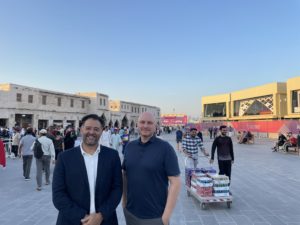
Telemundo’s Eli Velazquez (left) and Chris Suarez-Meyers at the Souq Waqif in Doha
“When we came the first time, we came out of this exit of the Souq and really liked the fact that we saw people constantly coming in and out,” says Velazquez. “We also wanted to get something that spoke to the culture and sense of place. In my opinion, a skyline’s a skyline, and, after a couple of days, you’re probably going to get somewhat bored of it. With constant movement, there’s always going to be something different that you can get from this experience.”
The development of a clear vision allowed the team to bring on partners. Tapping HD Studios as lead designer and needing to get an accurate portrayal of the feelings they wanted to convey, Telemundo brought in HD Studios owner/Principal Designer Bryan Higgason to get a taste of Doha. As the plan began to take shape, Higgason worked closely with NBCUniversal SVP, Marketing and Creative, Claudia Chagui and VP, Brand Design, Chris Moore to mesh the broadcaster’s marketing promotions, creative vision for the production, and tangible elements seen in the space.
“We had him come out and walk around to immerse himself in the culture for five days,” adds Velazquez. “He came to snap some photos and look at shapes and different designs that he eventually integrated into the look of our promotional campaign.”
The Spot in the Souq: A Window for Views, Multiple Talent Locations
Once the physical work began, Black Walnut was called on to put the details and pieces together, and LDG Lighting Design Group was tasked with making the set pop. The final product is a hub that perfectly achieves the initial goal. The main piece, a couch set with a window facing the Souq for a conversational vibe during live World Cup editions of Hoy en la Copa, ties together the subtle details immediately noticeable in the wide variety of studio programming.
The details include nods to the venues hosting all 64 matches, including archways reminiscent of the exterior of Lusail Stadium, fabric that matches the carpet covering the interior roof of Al Bayt Stadium, and a ceiling fixture that mimics the broadcaster’s Copa Mundial logo created by Chagui and Moore. An archway taken from the set is positioned at the broadcaster’s permanent studio inside Lusail Stadium, where the FIFA World Cup Final will take place on Sunday, Dec. 18. Also emanating from this set are Viva el Mundial, Debate Mundial, and Al Rojo Vivo.
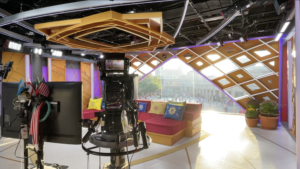
The main studio location features a conversation-style couch and a large window overlooking the marketplace.
Opposite the couch setting, a desk is available for a more professional aesthetic. In front of another window, a modular desk for halftime analysis can extend or contract depending on the number of talent participating. Each set is equipped with two hard cameras, a jib, and a handheld Steadicam. To maintain branding and continuity, Telemundo has a similar setup in the IBC. From either end, the dual-sided room has demonstrated its flexibility in a location that bustles with activity at all hours of the day and night.
“The thing I love about this particular look and feel is the colors that seem to unite all the teams playing in the World Cup,” says Velazquez. “The people that sit on each of these shows are also extremely fun.”
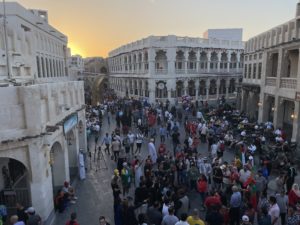
Fans gather beneath Telemundo’s Bismillah Hotel location.
Since the farthest stadium is only an hour away, the pool of talent has been expanded to cover every single aspect of not only the studio side but also in-venue commentary for live broadcasts. During the Group Stage, the action is typically frenetic. For previous World Cups, announce teams were required to travel to different cities during the tournament. For this year’s version, Telemundo opted to roll with four main announce teams dedicated to their own national teams.
That way, the broadcaster could reduce workload by supplying hyper-focused reporting and giving each team more time to adapt to changing storylines and news. With a revolving schedule of teams, a well-rested personality could be used in the booth one day and on the studio set the next.
“This would allow us to refresh the air and give them time to decompress,” says Velazquez. “When Brazil wasn’t playing, a person like [retired player] Mauro Silva would be used the day before or the day after their match. This idea took a lot of logistical planning and coordinating transportation to take talent to and from their assignments, but they’ve done great so far.”
Old and New: Bismillah Hotel, Skyline Position Tell the City’s Story
In the same location as the main studio, Telemundo is utilizing every inch of the broadcast compound. Sitting alongside facilities of other non–English-language broadcasters — Italy’s RAI, Mexico’s TV Azteca, DirecTV Latin America, Canada’s TSN — Telemundo’s small alcove points toward the city’s bright future. A drastic comparison to the adobe-like building in the Souq, this backdrop features the sparkling water of Doha Bay, the skyscrapers jutting out from the Doha Corniche, and a feeling of progress that is always evolving. It’s another pillar of Velazquez’s scheme: shedding light on multiple eras while mixing them with the images sent to viewers back home.
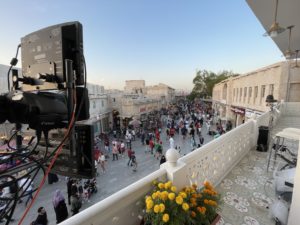
A camera at the Bismillah Hotel shoots down the main thoroughfare.
“We want to be able to control our environment but also bring folks back home into what you would think of when you would think of Qatar or the Middle East,” he says. “Our compound gives us the opportunity to also showcase the modernity of the country, and we thought that we needed a balance of both [old and new].”
Away from the main entrance to the Souq, Telemundo Deportes has claimed other spots to showcase the marketplace. Deep inside the Souq is the Bismillah Hotel, a two-suite hotel with a bird’s-eye view of the heart of the market. Through discussions with the building’s owner and plotting out the space needed to stand out on television, the broadcaster has a standup position for not only its own talent but also as a shared location with its news division and other networks in Doha. The main attraction is the balcony, which houses a handful of cameras, but the edifice also allows a more intimate atmosphere with two chairs stationed on the inside. With Qatari iconography like metal tea pots and intricate rugs, it’s an idyllic setting. Away from the Souq Waqif, Telemundo also has an activation at the FIFA Fan Festival at Al Bidda Park.
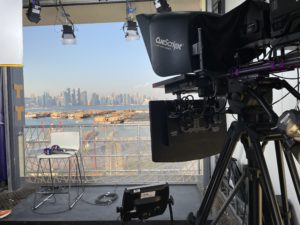
This standup location features the modern skyline of downtown Doha.
All the studio locations offer the opportunity to interact with the public. With the world descending on Doha, this has included capturing fan marches prior to games, fan celebrations, and a down-to-earth approach that places supporters of all nations at the core of Telemundo Deportes shows. Leveraging a roaming RF Steadicam, this setup has offered spontaneous and unforeseen opportunities for onscreen memories with fans attending the tournament. Like a shopper eyeing the perfect memento to capture their time at this global event, Telemundo has experienced a handful of coincidences that have created TV magic.
“You never know who you’re going to find in the crowd,” says Suarez-Meyers. “One of our talent is a former player from Mexico, and, coincidentally, a guy standing behind him was wearing his club jersey. That’s a moment that can happen only down here. What amazes me is that there are no official viewing parties, so all of the fans seem to be gravitating to the Souq as the center of the fan universe.”
Connection to Home: Compound Links to IBC, Telemundo Center in Miami
Located beneath the main set is the broadcast compound that makes each show possible. Relying on the expertise of Host Broadcast Services (HBS), Telemundo was given a sizable slice of this tourist destination. Boasting a crew of around 50 staffers from 29 countries and an engineering room that links to the International Broadcast Centre at Qatar National Convention Centre and the stateside team at Telemundo Center in Miami, the facility provides the infrastructure needed to adjust to the sightlines requested by Telemundo.
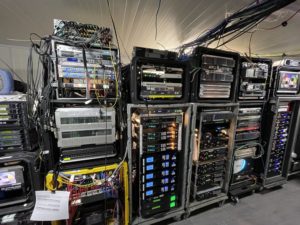
Telemundo’s engineering room at the studio compound
“We have probably the largest footprint within the compound,” says Suarez-Meyer. “Because of the way that [the compound] is designed, HBS wasn’t able to actually put traditional cabins under here, so our studio went from being a rectangle to a crescent shape.”
Luckily for Telemundo, HSB is responsible for working with the vendors stationed at the Souq. With a massive slate of content being shot from this location and distribution of live feeds of matches to the masses, it’s one less thing on the to-do list. And since the crew has been in Qatar for an extended period that included Thanksgiving, this two-week install will be deconstructed in three days to get employees home in time for Christmas and New Year’s.
“It’s a huge convenience for us to go through HBS because they take care of permitting,” Suarez-Meyers explains. “The time that it would’ve taken us to build our own facility from scratch would’ve required us to be here a few months before we actually landed.”
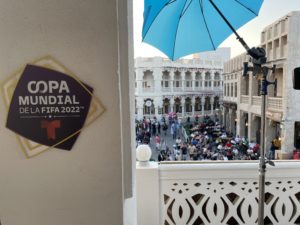
The network is producing more than 2,000 hours of Spanish-language coverage.
Back home in Florida, the broadcaster is producing shows that run concurrently with the shows in Doha. Headlining the slate in Studio A is Zona Mixta: Edición Mundial, and the space is also ready as a contingency plan if a studio were to go offline at the Souq. To manage team morale and efficiency, the pair of Director, Production, Adrian Costas and Pardo is holding down the fort to give crews a breather if needed.
“During the group stage, we were going on the air as early as 4:00 in the morning and would go all the way through to 5:00 pm, so it was a tough stretch,” says Velazquez. “[Pardo and Costas] are doing a phenomenal job of making sure that the teams are constantly shifting in and out.”
Final Phases Ahead: Ratings, Staff Energy Levels Rise Through Round of 16
Transitioning to the Quarterfinals, Telemundo has done tremendously in terms of viewership. As the linear side garners massive numbers, the team is extremely pleased with digital consumption on Peacock. Matches featuring the U.S. and Mexico have piqued interest, but, even more impressive, there has been an uptick in matches that typically wouldn’t resonate with the Hispanic audience. Overall, a mixture of the progress made by the U.S. Men’s National Team and stunning upsets in the Group Stage and Round of 16, Telemundo is enjoying a wave of momentum with the powerhouses left in play and the prospect of the 2026 FIFA Men’s World Cup in the North America in four years’ time.
“With the star power of the teams that are remaining, we’re still getting more viewers than we were used to on the digital side,” says Velazquez. “Soccer is already big globally, and it wants to grow in the U.S to get even bigger.”
All business aside, this year’s event is a crown jewel for Telemundo, and the broadcaster is treating its hardworking team as family — the way it treats viewers at home.
“We’re trying to keep them focused in order to finish strong,” says Velazquez. “Despite that, we’ve been able to maintain an environment where people are feeling valued and having a good time.”
